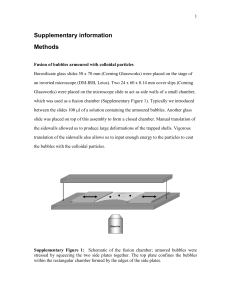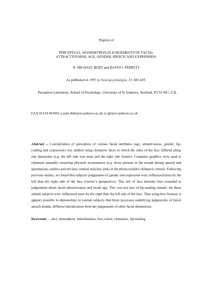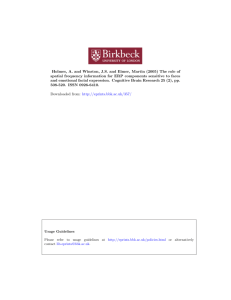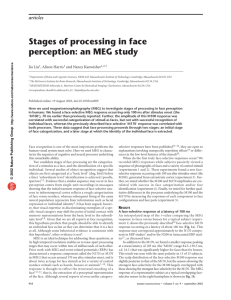A mechanism for impaired fear recognition after amygdala damage
advertisement
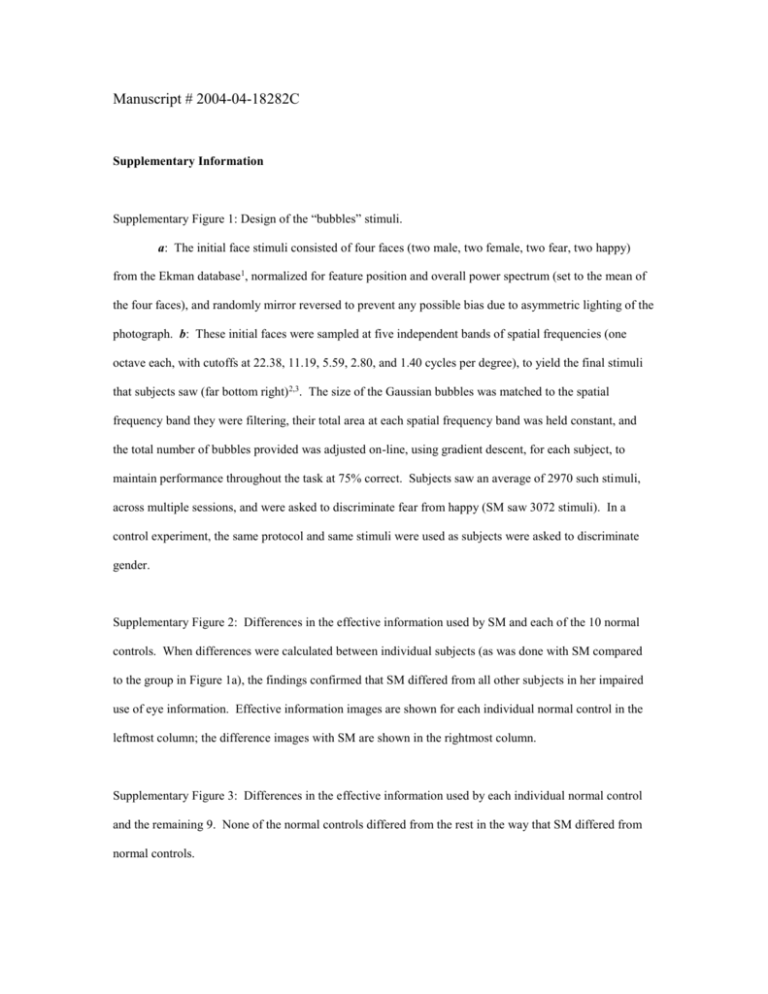
Manuscript # 2004-04-18282C Supplementary Information Supplementary Figure 1: Design of the “bubbles” stimuli. a: The initial face stimuli consisted of four faces (two male, two female, two fear, two happy) from the Ekman database1, normalized for feature position and overall power spectrum (set to the mean of the four faces), and randomly mirror reversed to prevent any possible bias due to asymmetric lighting of the photograph. b: These initial faces were sampled at five independent bands of spatial frequencies (one octave each, with cutoffs at 22.38, 11.19, 5.59, 2.80, and 1.40 cycles per degree), to yield the final stimuli that subjects saw (far bottom right)2,3. The size of the Gaussian bubbles was matched to the spatial frequency band they were filtering, their total area at each spatial frequency band was held constant, and the total number of bubbles provided was adjusted on-line, using gradient descent, for each subject, to maintain performance throughout the task at 75% correct. Subjects saw an average of 2970 such stimuli, across multiple sessions, and were asked to discriminate fear from happy (SM saw 3072 stimuli). In a control experiment, the same protocol and same stimuli were used as subjects were asked to discriminate gender. Supplementary Figure 2: Differences in the effective information used by SM and each of the 10 normal controls. When differences were calculated between individual subjects (as was done with SM compared to the group in Figure 1a), the findings confirmed that SM differed from all other subjects in her impaired use of eye information. Effective information images are shown for each individual normal control in the leftmost column; the difference images with SM are shown in the rightmost column. Supplementary Figure 3: Differences in the effective information used by each individual normal control and the remaining 9. None of the normal controls differed from the rest in the way that SM differed from normal controls. Supplementary Figure 4: Effective information used by subjects with unilateral amygdala damage. Subjects with unilateral amygdala damage, like normal controls, made substantial use of the eye region of the face in high spatial frequencies. Supplementary Figure 5: Effective information used by SM and normal controls in discriminating gender. In this control experiment, we used identical stimuli and protocol as for the emotion discrimination bubbles task, but instead asked subjects to discriminate gender from the revealed faces. SM and controls used identical effective information; their difference image (Controls-SM, not shown) was uniformly grey. SM did use high spatial frequency information, from one of the eyes and the mouth, when asked to discriminate gender. Supplementary Table 1: Accuracy in recognizing emotions from whole faces, or from the same faces but with the eye region erased. Means and SD from 12 normal controls and SM (mean performance from 2 separate experiments) are shown. FULL FACES: happy Control avg. 0.98 S.D. 0.05 surprised 0.99 0.05 afraid 0.93 0.13 angry 0.90 0.07 1.00 0.83 0.33 1.00 happy Control avg. 1.00 S.D. 0.00 surprised 0.85 0.29 afraid 0.59 0.28 angry 0.82 0.15 1.00 0.33 1.00 SM disgusted 0.68 0.23 sad 0.85 0.24 0.86 1.00 EYES ERASED: SM 1.00 disgusted 0.79 0.10 0.71 sad 0.57 0.28 0.80 References: 1. 2. 3. Ekman, P. & Friesen, W. Pictures of facial affect (Consulting Psychologists Press, Palo Alto, CA, 1976). Gosselin, F. & Schyns, P. G. Bubbles: a technique to reveal the use of information in recognition. Vision Research 41, 2261-2271 (2001). Schyns, P. G., Bonnar, L. & Gosselin, F. Show me the features! Understanding recognition from the use of visual information. Psychological Science 13, 402-409 (2002).



